European Travels 8 – Denmark: Zealand and Copenhagen
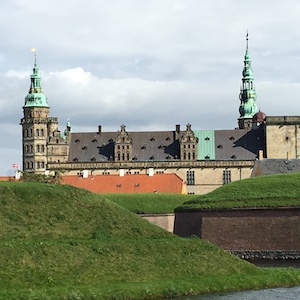 This post continues our European Travel 7 post From Sylt to Zealand. Before heading into Copenhagen, we wanted to explore the northern part of the island of Zealand. There was one castle in particular that interested us.
This post continues our European Travel 7 post From Sylt to Zealand. Before heading into Copenhagen, we wanted to explore the northern part of the island of Zealand. There was one castle in particular that interested us.
Kronborgslot
Kronborgslot, a 16th century castle, located at the very tip of Helsingør and overlooking the Øresund across to Sweden, may very well be Denmark's most famous castle. It's the castle that Shakespeare called Elsinore in his play Hamlet.
Since 1816, every year in August, and only interrupted by World War II, the Hamlet festival attracts not only thousands of visitors, but also the world's greatest actors. While we regretfully missed the festival, we were surprised how many names of actors we recognized in the Festival's “Hall of Fame”.
They include Sir Laurence Olivier, Vivien Leigh, Gustaf Gründgens, 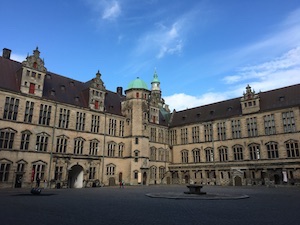 Sir John Gielgud, Michael Redgrave, Richard Burton as well as Michael Caine, Christopher Plummer, Kenneth Branagh, Jude Law, and other more recent ones.
Sir John Gielgud, Michael Redgrave, Richard Burton as well as Michael Caine, Christopher Plummer, Kenneth Branagh, Jude Law, and other more recent ones.
Since the year 2000 Kronborg Castle has been a UNESCO World Heritage Site and has been called one of the most important Renaissance castles of northern Europe.
In 1574 King Frederick II started construction to transform the Krogen (the castle's original name) into a Renaissance castle, which was finished in 1585. A tour of the grounds and through the building let us appreciate its strategic location, as well as its significance as a sign of the power and wealth of King Frederick II.
When a fire destroyed a large part in 1629, King Christian IV had it rebuilt. Besieged and captured by the Swedes in 1658, the castle also lost many of its art treasures. For close to 150 years it was used to house the army and only in 1923, after a thorough renovation, it was opened to the public.
The Maritime Museum of Denmark
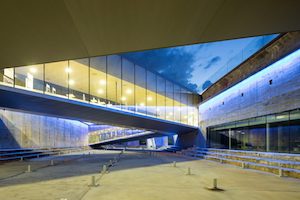 On our way from the parking lot to the Kronborg Castle, we came by what looked like, and indeed was a former dry dock: the Maritime Museum of Denmark. We have to admit that it wasn't on our museum list, although it should have been. As we learned from the website:
On our way from the parking lot to the Kronborg Castle, we came by what looked like, and indeed was a former dry dock: the Maritime Museum of Denmark. We have to admit that it wasn't on our museum list, although it should have been. As we learned from the website:
“In 2014 the museum was listed as one of The New York Times’ recommended ‘52 places to go in 2014’ and voted the best cultural building worldwide by archdaily.com – the world’s most visited architecture website. In October 2014, BBC made a list of the 8 greatest new museums in the world which featured the Maritime Museum of Denmark. In January 2015, National Geographic listed 10 structures that it recommended traveling to for the design alone, and the Maritime Museum of Denmark was one of them.”
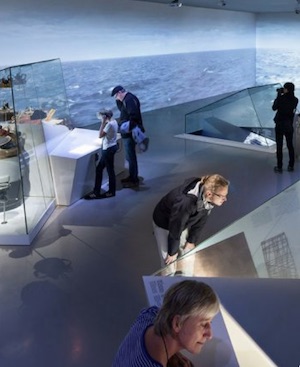 The museum is not only an architectural delight. Being an avid sailor and fan of everything nautical, I probably enjoyed this visit even more than walking through any castle. I have been to many maritime museums, visited old sailing ships, destroyers, aircraft carriers, battle ships and submarines. But, never have I seen the maritime history and life on sea as comprehensively depicted and exhibited.
The museum is not only an architectural delight. Being an avid sailor and fan of everything nautical, I probably enjoyed this visit even more than walking through any castle. I have been to many maritime museums, visited old sailing ships, destroyers, aircraft carriers, battle ships and submarines. But, never have I seen the maritime history and life on sea as comprehensively depicted and exhibited.
The whole experience was stunning. Walking down the sloped exhibition floors and taking in the various exhibits with great sound and video effects was informative and fascinating. (There is a discount if you visit both the Kronborg Castle and the Maritime Museum the same day.)
As we continued to explore the countryside of northern Zealand with its green pastures and little villages, we could not forgo visiting another important castle and museum.
Frederiksborgslot
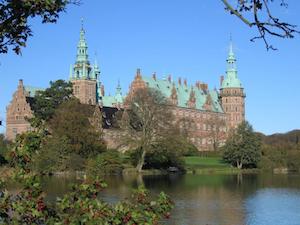 Frederiksborgslot is another picture-perfect Danish Renaissance castle which also houses the Danish Museum of National History. From Kronborg Castle it's only a half hour drive (or 17 miles) to Hillerød where Frederiksborg Castle faces the town across a small lake.
Frederiksborgslot is another picture-perfect Danish Renaissance castle which also houses the Danish Museum of National History. From Kronborg Castle it's only a half hour drive (or 17 miles) to Hillerød where Frederiksborg Castle faces the town across a small lake.
King Frederick II acquired the original castle in 1560 and gave it its name. King Christian IV, in the early decades of the 17th century, substantially expanded and made it the largest Renaissance castle in Scandinavia. (You may remember from above that Christian IV was also responsible for rebuilding Kronborg Castle after a fire had destroyed a large part it.)
The castle was used as a main royal residence for the first 100 years. It later fell into disuse until Frederick VII began to occupy it again in 1848.
After a fire in 1859 destroyed much of the interior and roofs, its fate was uncertain, until Jacob Christian Jacobsen, the founder of the Carlsberg Breweries, restored it. In 1877, he proposed to make it the home of the Danish Museum of National History. A branch of the Carlsberg Foundation, to whom Jacobsen bequeathed his fortune, still runs the museum and castle today.
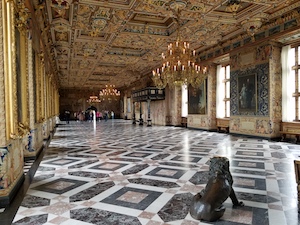 Our tour through the museum took us through several hundred years of Danish history from the Middle Ages to the 21st century.We could fully appreciate the size of castle property by looking from the castle across the lake to the Barock garden, with its terraces, trees, hedges, and fountains. (see picture)
Our tour through the museum took us through several hundred years of Danish history from the Middle Ages to the 21st century.We could fully appreciate the size of castle property by looking from the castle across the lake to the Barock garden, with its terraces, trees, hedges, and fountains. (see picture)
We also became aware of an interesting tradition for choosing the names of Danish Kings, which started in the 16th century: After Christian II (1513 –1523) - and until Margrethe II became Queen in 1972 - Danish kings were called either Frederick or Christian. Curiously enough, no one could explain to us the tradition's origin.
And – a little more Scandinavian royal history – the son of Fredrick VIII (1906-1912), Prince Carl of Denmark, became one of the few elected monarchs in modern history. Norway recruited him and, King Haakon VII, he became the first king of Norway after the 1905 dissolution of Norway's union with Sweden.
Louisiana Museum of Modern Art
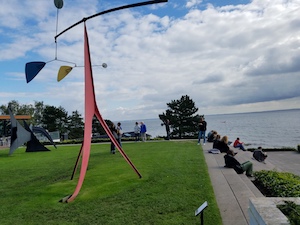 Frederiksborg Castle and the Museum of National History were just the first examples of philanthropic endeavors we encountered in Denmark. We saw several more in Copenhagen. And, the “Louisiana” belongs in that group as well. We had heard about the museum as a must see when in the Copenhagen area. Its name already intrigued us and we soon found out from the guide book:
Frederiksborg Castle and the Museum of National History were just the first examples of philanthropic endeavors we encountered in Denmark. We saw several more in Copenhagen. And, the “Louisiana” belongs in that group as well. We had heard about the museum as a must see when in the Copenhagen area. Its name already intrigued us and we soon found out from the guide book:
“The name Louisiana, pleasant and lilting in Danish, has a curious story in its own right: the original villa (a 19th century country house) was named for its first owner's marriages to no fewer than three women named Louise.”
The Louisiana was already a different type of museum when Knud W. Jensen founded it and opened its doors in 1958. When we visited it now nearly 60 years later, the setting overlooking the Sound, was still amazing. The various galleries meander through the garden and sculpture park.
The architecture by Danish architects Vilhelm Wohlert and Jørgen Bo was clearly inspired by the German Bauhaus (a school founded by the architect Walter Gropius, in 1919 in Weimar). Jensen, we understood, was very much the third architect and he kept expanding and building until his death in 2000. The result is a structure that creates wonderful exhibition spaces for modern art collections of photography, paintings, sculptures, videos, etc.
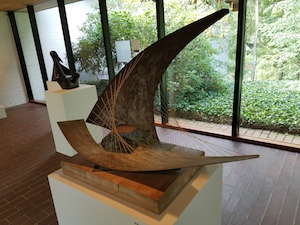 The Giacometti Gallery with its many sculptures and reflections from the lake below is one of the highlights.There are works by Picasso and Warhol, Lichtenstein, as well as by Ai Weiwei, and Danish artists we were not familiar with.
The Giacometti Gallery with its many sculptures and reflections from the lake below is one of the highlights.There are works by Picasso and Warhol, Lichtenstein, as well as by Ai Weiwei, and Danish artists we were not familiar with.
Special exhibitions of international and Danish artists change periodically. During our visit we experienced the first major retrospective presentation of the controversial body and performance artist Marina Abramovic. Even if modern art is not your thing – experiencing the Louisiana should be on your Copenhagen itinerary.
(The Louisiana Museum of Modern Art is located 25 miles north of Copenhagen. If you don't have a car: On the Danish State Railway (DSB), the Sound coastal route takes about 35 minutes from Copenhagen’s Central Station and 10 minutes from Helsingør. From Humlebæk Station, it is a 10-minute walk to the museum. You can buy e-tickets in advance on the site link above.)
Copenhagen
After traveling for over 10 days by car (from the Netherlands to Lüneburg and Sylt ), we looked forward to staying in one place for a while. We had rented an apartment in Copenhagen and easily found it upon arrival.
Returning the rental car (and mailing back the mywebspot pocket WIFI, which had served us well on the road), gave us an opportunity to explore Copenhagen's transit system and the neighborhood of Fredericksberg, where our apartment was located.
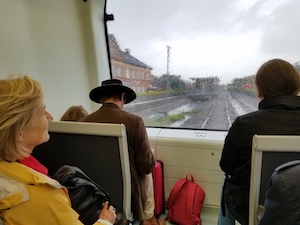 The subway into town (and to the airport) was only a 4-minute walk away and we discovered that the M2 metro back to our apartment was not only driver-less, but ran like clockwork, every 2-6 minutes during the day (every 15-20 minutes at night).
The subway into town (and to the airport) was only a 4-minute walk away and we discovered that the M2 metro back to our apartment was not only driver-less, but ran like clockwork, every 2-6 minutes during the day (every 15-20 minutes at night).
The first two metro lines were completed between 2003 and 2007. A city loop is expected to open in 2019 and more extensions in the following years. The metro system supplements a very effective S-train rapid transit system, and a bus network, both of which we also used during our stay.
The wonderful apartment – with modern Danish furniture - had WIFI, maps and city guides. We first familiarized ourselves a little more with the city's history.
A Little Copenhagen History
Getting its start as a Viking fishing village in the 10th century, Copenhagen became Denmark's capital in the 15th century. With a population of over 700,000, it's also the country's largest city today. And, it was again Christian IV, who between 1588 and 1648, was most responsible for Copenhagen's growth and building boom.
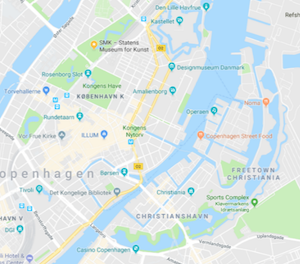 He initiated a number of building projects, including the Stock Exchange, the Rosenborg Slot and the district of Christianshavn (see later) with canals and ramparts.The city's fortifications, however, proved no match for the British attack in 1807 when most of the city was destroyed.
He initiated a number of building projects, including the Stock Exchange, the Rosenborg Slot and the district of Christianshavn (see later) with canals and ramparts.The city's fortifications, however, proved no match for the British attack in 1807 when most of the city was destroyed.
Nevertheless, after the war, and inspite of Denmark declaring bankruptcy in 1813, Copenhagen underwent a period of rebuilding and intense cultural activity, also known as the Danish Golden Age.
Nyhavn
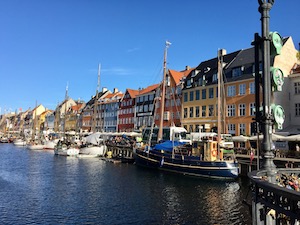 Nyhavn (new harbor) was originally constructed in 1670 by Christian V, as a gateway from the sea to Kongens Nytorv (King's Square) to handle cargo and fishermen's catch.
Nyhavn (new harbor) was originally constructed in 1670 by Christian V, as a gateway from the sea to Kongens Nytorv (King's Square) to handle cargo and fishermen's catch.
Today with its colorful buildings, dockside cafes and restaurants looking onto classic sailing ships and pleasure boats, Nyhavn has become one of Copenhagen's top tourist spots, great for people watching or just enjoying the scenery.
Hans Christian Andersen, the famous Danish fairy tale writer lived here for over twenty years at Nyhavn, when the harbor side was still a sailor's delight. 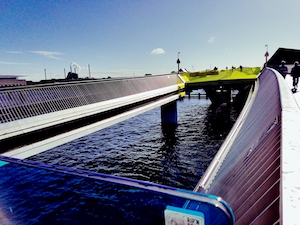 I was especially intrigued by the sliding pedestrian/bicycle bridge ("Inderhavensbroen") which spans the harbor to Christianshavn. Having gone under many fixed and opening bridges during our canal travels in France and the Netherlands (see European Travels 3: Dutch Language and Canal Boating) I've never encountered such a design.
I was especially intrigued by the sliding pedestrian/bicycle bridge ("Inderhavensbroen") which spans the harbor to Christianshavn. Having gone under many fixed and opening bridges during our canal travels in France and the Netherlands (see European Travels 3: Dutch Language and Canal Boating) I've never encountered such a design.
The bridge design is controversial to say the least. If you're interested, this article explains both the design and issues of the “Kissing Bridge”. I personally found it quite elegant and watched it open and close several times.
Hey Captain
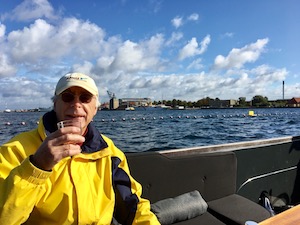 Right below the “Kissing Bridge” we met the boat for our harbor cruise. (We saw on the website that the departure has now moved across to the Ofelia Plads.)
Right below the “Kissing Bridge” we met the boat for our harbor cruise. (We saw on the website that the departure has now moved across to the Ofelia Plads.)
Rather than touring the harbor in one of the giant Canal Tour boats, we preferred the Hey Captain option with the yacht-club-type launch and a maximum of 12 guests (and including a complimentary drink).
Maybe because it was a mid-September Monday with rain in the forecast, but our tour included only one other guest from the US. So it was quite “private”.
Captain Mathias - who works as a ski instructor in South Tyrol during the winter – spoke excellent English and skillfully took us through the harbor. The tour went through the canal along Freetown Christiana (more about that below), the Frederiksholms Kanal by the Christiansborg Palace, etc. He interspersed his explanations of the historic sites with little gossip tidbits of the current life in Copenhagen. 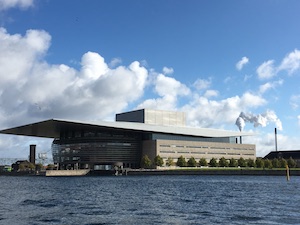 From the water we had a wonderful view of many of the signature buildings on both sides: The spectacular new Opera House on the Christianshavn side, (see picture), the Royal Danish Playhouse just across on the city side, the “Black Diamond” as the modern waterfront extension of the Royal Library is called. As we sailed by we indeed saw the glass facade sparkling glass like a diamond.
From the water we had a wonderful view of many of the signature buildings on both sides: The spectacular new Opera House on the Christianshavn side, (see picture), the Royal Danish Playhouse just across on the city side, the “Black Diamond” as the modern waterfront extension of the Royal Library is called. As we sailed by we indeed saw the glass facade sparkling glass like a diamond.
We really enjoyed the very informative 60 minute tour.
Palaces and Museums
After having visited several castles and palaces during our travels already, we decided to skip the Rosenborg Slot and the Amalienborg Slot, the seat of the Royal family. As the flags were flying, we understood that the Queen was in residence and we witnessed the changing of the guard – enjoyed by school children and adults alike.
Two Museums we liked in particular:
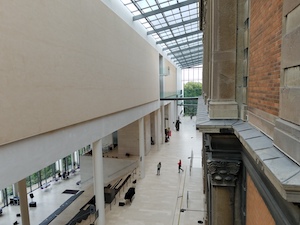 The SMK (Statens Museum for Kunst), the National Gallery of Denmark, is Denmark's largest art museum and houses collections of mainly Danish (but also international) artists of the past seven centuries.
The SMK (Statens Museum for Kunst), the National Gallery of Denmark, is Denmark's largest art museum and houses collections of mainly Danish (but also international) artists of the past seven centuries.
The original museum building of the 1890s has been expanded by a new addition in 1998 which holds the modern collection. When old and modern structures are joined (see picture) not everybody likes the result. But we did.
We also visited the David Collection, a fascinating collection of Islamic, European, and Danish Art. Housed in a building once occupied by the museum's founder, a prominent Copenhagen attorney, the extensive collection of Islamic Art is the most important one. It “encompasses exquisite decorative art from the 7th century to the mid-19th century from an area that extends from Spain in the west to China in the east, from Uzbekistan in the north to Yemen in the south.”
Bicycling and Segway
There are several ways you can do sightseeing in Copenhagen: In addition to typical bus tours, there are boat tours, kajak tours, bicycle tours and Segway tours and obviously – our preferred way, just walking.
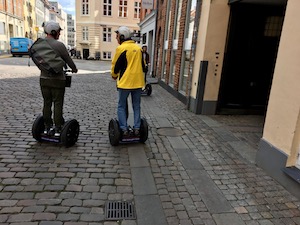 We rented electric bicycles several times to explore the neighborhood of Frederiksberg where our apartment was located, as well as Christianshavn, (see below) and loved the ubiquitous bike paths. However, we at first shied away from doing so in the middle of the city.
We rented electric bicycles several times to explore the neighborhood of Frederiksberg where our apartment was located, as well as Christianshavn, (see below) and loved the ubiquitous bike paths. However, we at first shied away from doing so in the middle of the city.
Therefore we felt quite brave when we decided to sign up for a Segway tour downtown. We had always wanted to try out a Segway and now had an opportunity to do so.
After about 15 minutes of instruction and tryout in the company's offices and on the street, our group of 12 riders assembled to follow the guide. Through our helmet speaker, we heard his instructions and off we went onto the next bike path. As bikers dashed by us we made our way slowly but surely through the city.
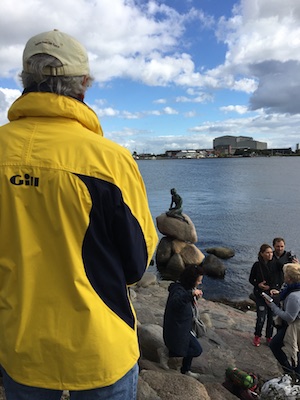 Once at the harbor promenade in front of the spectacular Skuespilhuset, the Royal Danish Playhouse (see picture above), we all felt that we had mastered the most difficult part of the Segway trip. We circled around the Amalienborg courtyard (where we had been before) and zipped through the Kastellet, one of the best preserved star fortresses in Northern Europe.
Once at the harbor promenade in front of the spectacular Skuespilhuset, the Royal Danish Playhouse (see picture above), we all felt that we had mastered the most difficult part of the Segway trip. We circled around the Amalienborg courtyard (where we had been before) and zipped through the Kastellet, one of the best preserved star fortresses in Northern Europe.
Finally, we stopped at the “Lille Havfrue”, the Little Mermaid, for more pictures: Indeed, the Little Mermaid - as both our Boat Captain as well as our Segway Tour Guide stressed - must be the world's most overrated tourist attraction from any vantage point. But we still took a picture just like everybody else!
It was amazing how much distance we covered in 90 minutes and how much information we absorbed during that time.
Christianshavn
The boat tour had taken us through the canals of Christianshavn and our Captain had told us various stories about this part of Copenhagen. (Our Segway Tour did not go over the bridge.)
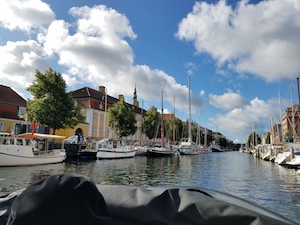 Developed in the early 17th century by Christian IV as part of the city's fortifications, and then as a merchants' town inspired by Dutch city planners, it became a working class neighborhood in the 20th Century with military housing. In the 70s it developed a bohemian reputation and became a favorite of students, hippies and artists.
Developed in the early 17th century by Christian IV as part of the city's fortifications, and then as a merchants' town inspired by Dutch city planners, it became a working class neighborhood in the 20th Century with military housing. In the 70s it developed a bohemian reputation and became a favorite of students, hippies and artists.
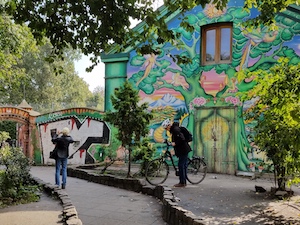 When the military left the Christiania area, students called out the “Fristaden Christiania”. Drugs and crime became a problem in the 80s. We were told that police now stay mostly away and self-government by the resident tries to keep the peace.
When the military left the Christiania area, students called out the “Fristaden Christiania”. Drugs and crime became a problem in the 80s. We were told that police now stay mostly away and self-government by the resident tries to keep the peace.
While the many types of cannabis that are openly sold are technically illegal, the law is not enforced and the situation is tolerated. We bicycled through the Freetown on a Sunday morning. A sign at the entrance proclaimed: “You are now leaving the European Union”. Many stands that sold cannabis, colorful jewelry and clothes were just being set up. 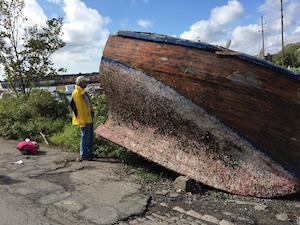 By midday the area was filled with families on a stroll, joggers, bicyclists and tourists like us.
By midday the area was filled with families on a stroll, joggers, bicyclists and tourists like us.
We heard some noises coming from the partial and overturned hull of an old wooded vessel, right alongside the shore of the Freetown's “marina”, and so we stopped: A young man was busy cleaning out the inside. He was clearly stoned and explained that this was going to be his new home. He invited us to come and visit him once it was finished.
Tivoli Gardens
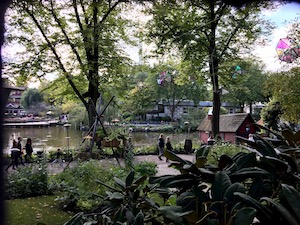 A visit to Copenhagen wouldn't be complete without a visit to Tivoli, the famous amusement park. Opened in 1843 by its founder Georg Carstensen, on land leased from King Christian VIII, it must have been a model for the Disney Parks over 100 years later.
A visit to Copenhagen wouldn't be complete without a visit to Tivoli, the famous amusement park. Opened in 1843 by its founder Georg Carstensen, on land leased from King Christian VIII, it must have been a model for the Disney Parks over 100 years later.
We did not take any of the many offered rides on roller coasters, or other contraptions like the “Vertigo”, a looping plane ride, or the “Zamperla”, a giant swing a spinner with 4G forces, or even the newest “Fatamorgana”. 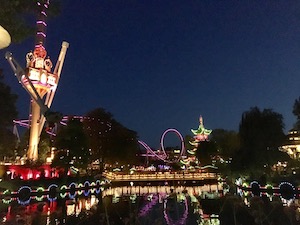 Leaving these to younger folks, we enjoyed walking around the gardens. We watched a ballet performance, listenend to a concert and had a delicious dinner in one of the numerous restaurants. In the evening, the many lights with the fireworks at the end created a magical atmosphere.
Leaving these to younger folks, we enjoyed walking around the gardens. We watched a ballet performance, listenend to a concert and had a delicious dinner in one of the numerous restaurants. In the evening, the many lights with the fireworks at the end created a magical atmosphere.
There are so many places to see and experience in Copenhagen, that even a week was not enough. You'll have to consult your travel guide to decide what to see and do.
If you have even less time than we did, this April 2018 New York Times article will give you some excellent suggestions: 36 Hours in Copenhagen We certainly enjoyed our time in Copenhagen and Denmark.
Bio: Ulrike & Peter Rettig are co-founders of Gamesforlanguage.com. They are lifelong language learners, growing up in several European countries before moving to Canada and the United States. You can follow them on Facebook, Twitter and Instagram, and leave any comments with contact.
